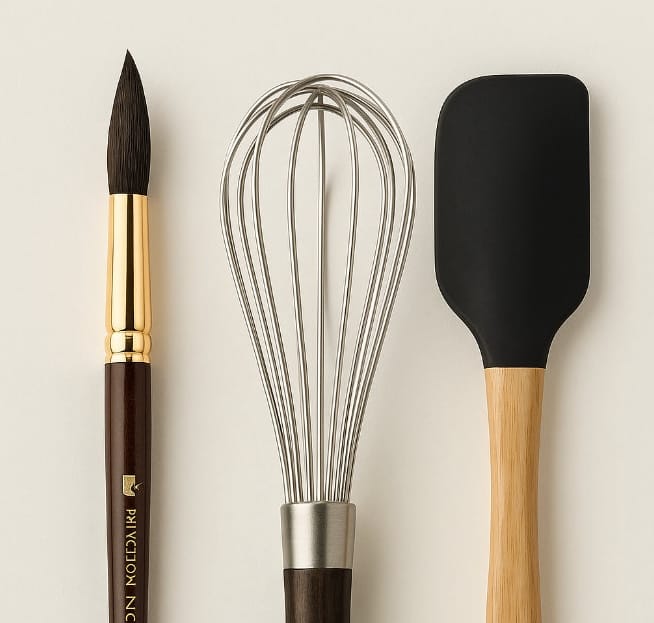The Top Four Watercolor Brushes for Masters-in-the-Making
I’m cooking up my top four watercolor brushes every artist needs. Think chef’s knife to whisk—essential tools for confidence and creativity at the easel.

Choosing the best watercolor brushes is a lot like stocking your kitchen. Sure, you could splurge on every shiny gadget—the pasta roller, the spiralizer, the blowtorch—and convince yourself it’ll make you a five-star chef overnight. I’ve been there. I thought my $150 Da Vinci mop brush would instantly land me on the cover of Watercolor Magazine (still waiting for that phone call).
More Watercolor Essentials
- 👉 Before you grab a brush, make sure you’ve seen my breakdown of the best watercolor paint for beginners (artist grade vs. student grade).
- 👉 And don’t miss my guide to the best watercolor paper — because even great brushes need the right surface.
Turns out, brushes don’t make masterpieces. Practice does. But the right tools definitely help. After wasting cash on “miracle” brushes, I landed on a small set that actually works. Affordable, durable, and versatile—these are the brushes that slice, dice, and whisk their way through my daily painting routine.

#1. Silver Black Velvet Jumbo Wash
This brush really slices through the competition. It’s affordable, durable, and a workhorse for big washes. Take it from me—I’m a heavy-handed painter, and mine is still going strong after years. Think of it as your chef’s knife: the one tool you always grab, no matter what’s on the menu.
#2. Princeton Neptune Pointed Round No. 12
If the Silver Black Velvet is the knife, the Princeton Neptune #12 is your trusty skillet. Balanced, versatile, and perfect for all-around cooking—er, painting. It’s soft enough for washes, stiff enough for detail, and forgiving enough that beginners won’t ruin a painting with one bad stroke. Add the smaller No. 6 (below), and you’ve got a complete set of “pans” to cook up any watercolor dish.
#3. Princeton Neptune Pointed Round No. 6
This one’s the paring knife. You don’t use it all the time, but when you need it—fine branches, tiny highlights, small details—nothing else will do. Small, precise, and sharp. Without it, the dish just isn’t finished.
#4. Princeton Neptune Dagger ½″ (or ⅜″)
This brush is my whisk, and it can really mix things up. It’s expressive, versatile, and sometimes unpredictable in the best way. With it, you can whip up bold calligraphic strokes, fold in some washes, or sprinkle in playful lines. It’s the tool that keeps things loose and lively. Many paintings I’ve done used nothing but the dagger—it’s that good.

Natural vs. Synthetic Bristles
- Natural Hair (squirrel, ox, etc.) → Like caviar—expensive, delicate, and not always worth it for everyday cooking.
- Synthetic Blends (like Silver Black Velvet & Princeton Neptune) → Affordable, durable, and high-quality. This is your bread and butter—what I use daily, and what I recommend.
What Sizes Do You Actually Need?
Think large, medium, small—just like meal prep:
- Big brushes for covering the whole canvas.
- Medium brushes for shapes and smaller areas.
- Small brushes for details and highlights.
A few well-chosen brushes are enough to cook up a full painting. You don’t need the whole kitchen store.
FAQ
Q: Do beginners need natural hair brushes (squirrel, kolinsky), or are synthetics fine?
A: Synthetics and synthetic blends are perfect for beginners—affordable, durable, and great performance. Natural hair can be fantastic, but it’s pricey and high-maintenance.
Q: What four brushes will cover most watercolor techniques?
A: A large wash brush (Silver Black Velvet Jumbo), a pointed round #12, a smaller pointed round #6, and a dagger ½″ (or ⅜″). That set handles washes, shapes, details, and expressive marks.
Q: Why do you recommend a dagger? Isn’t it a specialty brush?
A: It’s my “whisk.” Daggers can make crisp lines, calligraphic strokes, and even medium washes. Super versatile and great for loose, expressive painting.
Q: How do I choose sizes?
A: Think large → medium → small. One big wash brush for coverage, a #12 for general work, and a #6 for details. Add a dagger for expressive strokes.
Q: How do I care for watercolor brushes so they last?
A: Rinse in clean water (no hot water), reshape the tip, let them dry horizontally or bristles-down, and never leave them sitting in water.
Q: Are expensive natural brushes “worth it”?
A: Only if you know why you need them. For most beginners (and many pros), modern synthetics deliver excellent results at a fraction of the cost.
Final Thoughts
Brushes aren’t magic wands. They won’t instantly make your paintings Michelin-star worthy. But with these four, you’ll have the equivalent of a well-stocked kitchen: a chef’s knife, skillet, paring knife, and whisk. Everything else is optional.




